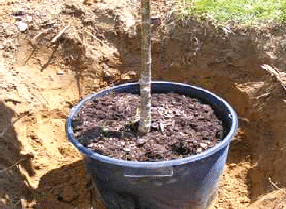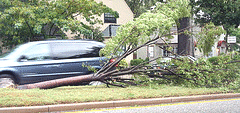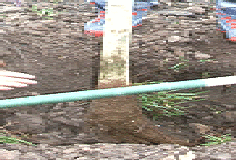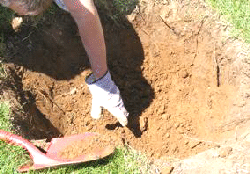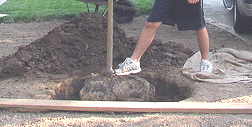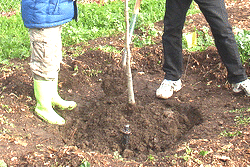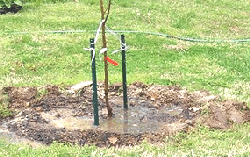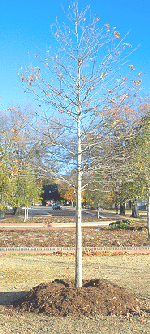Planting a Tree
Planting a tree seems pretty simple, and it is. But there are some things you can do to help the tree establish and ensure healthy growth
The basics of planting a tree are pretty simple, especially if you have selected a tree that prefers your growing zone, planting site conditions and soil type. But there are many factors that may require special steps to ensure that the tree thrives. Special circumstances to accommodate when planting a tree are covered on the next page.
When is the best time to plant a tree?
Opinions vary about the absolute best time to plant a tree. But there are two times that are definitely at the top of the list, early spring and early autumn. Absolutely avoid the heat of summer if at all possible. Nothing is harder on a new plant than trying to struggle through heat and drought. Even a north winter is not as stressful.
Trees can be spring planted as soon as the ground has thawed. Especially for a bare root tree which is still dormant, it will be allowed to break dormancy as the soil warms. Bare root trees are generally only available just past your frost free date and should be planted immediately since the roots are exposed. Container grown and balled and burlapped trees can be planted anytime in spring after the ground has thawed up until the heat of summer sets in.
The fall planting season begins as soon as the heat and drought of summer in your area has passed. Planting can continue up until about 6 weeks before the ground begins to freeze. This will give your tree some time to establish roots and soak up as much water as it needs to for its’ winter dormancy. Roots are growing quite aggressively about the time the leaves are falling. If you plant a little late, make sure you mulch about 3 feet around your tree to keep the soil warm a bit longer for the roots to establish.
How to Plant a Tree
Digging the hole is the most important step in planting a tree. The new tree will need the help of loosening the soil to spread and establish its’ roots. The hole should be at least twice as wide as the root ball and one and a half times as deep. Discard the turf grass removed (better yet, put it in your compost heap!) and place the removed soil in a wheelbarrow or on a tarp as you remove it. It may also be piled around the hole, you will just need to rake the remnants out of the grass when you are done
The tree should be planted at the same depth it was originally grown. A tree planted too deep may snap in high winds. Young trees naturally sway and bend at ground level, but planted too deep it cannot, and is more likely to snap near to the ground. A tree planted too shallow may pull right out of the ground in high winds, and the roots will not be adequately protected by soil. The level of the soil when planting is complete should be at the original soil level or just slightly above it to allow for settling. The original soil level is easy to determine on a container grown or balled and burlapped tree. It is a little less evident on a bare root or “manufactured ball” tree (more on that later). Look at the base of the trunk and you should be able to see the original soil line. The trunk will be slightly discolored below the soil line, usually darker.
Before back filling the bottom of the hole, measure the height of the root ball or height from the lowest point to the original soil line with a yardstick. Place a board across the hole so you can measure the depth when filling the bottom of the hole. The board can also help make sure the soil line of the trunk is level with the ground once you have placed in the hole.
New opinions by Landscape Horticulturists about amending the soil when planting trees have emerged in recent years. Most horticulturists are recommending that back fill around the new root ball should be only the original soil with no amendments added. This forces the tree to immediately adapt to the conditions it must live in. Trees that are planted in a hole full of amendments and rich soil tend to want to “stay in the hole” where conditions are so nice. The roots grow in circles to stay in the hole and become root bound. The tree then cannot take in enough moisture in dry periods as they would with deep and far reaching roots. Such a tree might also be easily toppled in a storm because it is not anchored deeply. I tend to agree, and have adjusted my own planting with minor exceptions (some of which will be covered later). If you are planting in heavy clay or sand, you may want to mix in some peat moss. Heavy clay may become waterlogged and sand will not hold moisture. Both present poor conditions for a tree to get started unless you have carefully selected a tree that prefers your soil conditions. But since we often select based on appearance or function, the tree might need a little help. Adding peat to your soil will provide drainage to heavy clay, and aide water retention for sand.
Fill the bottom of the hole to the appropriate depth. Water the back fill to make sure it settles and you maintain the proper depth. Then place the tree in the hole to check the planting depth. This should be done without removing the container or burlap so the root ball is not disturbed until it is ready to plant. If additional back fill is needed, remove the tree and continue to add fill until the proper depth is reached. Then remove the tree from the container or remove the burlap and place in the hole. If the ball and burlap is very large and hard to handle, place it in the hole with burlap in place to minimize root disturbance and make the handling easier. Then cut away the burlap as much as possible. Burlap that cannot be easily removed will rot away relatively quickly and will not affect the root growth.
Partially fill the hole around the root ball with soil, about two thirds full. Thoroughly soak the back filled soil to settle the soil, and tamp lightly with your foot or hands to remove air pockets. Continue filling and soaking until the hole is filled to ground level. If your tree has settled too low through the process, firmly grasp the base of the trunk and slightly pull upward while soaking the soil to settle under the root ball. Level and smooth the surface, raking soil deposited in the grass into the hole.
There should be some removed soil left since part of the hole was filled with the tree’s root ball itself. Use this to form a saucer effect around a tree. Build up about a 2 inch dam all the way around to help hold in water to soak into the hole. Then thoroughly soak the tree once a week for the first several weeks. Staking and guying a small tree is not necessary and may damage the tree. A small tree properly planted does not have enough mass to be pulled over by wind. The ties stress the trunk and damage the bark. The tree does not develop good wind resistance strength. As previously mentioned, young trees naturally bend and sway in the wind. And a staked tree is more likely to snap at the point the guys are tied in a strong wind because the tree is not being allowed to move. As long is the tree is less than six feet tall or only one inch or less is diameter, do not stake the tree. Deep anchor roots will establish to hold the tree in the soil.
Mulch can be applied to help the tree retain water. Summer mulch should be applied lightly, just enough to cover the soil well. This will not only help the soil to stay moist, but will reduce weeds. The mulch should not be applied directly around the base of the trunk. Additional mulch can be applied just after the ground freezes. A deep layer of mulch, a few to several inches, will help the soil maintain a more constant temperature. Soil that constantly freezes and thaws can cause damage to the roots or even heave the root ball right up out of the ground. Winter mulch should be applied in a “donut” fashion, again not applied directly around the base of the trunk. Trees that are well suited to your region and soil conditions should normally not need winter protection. But if you are planting a marginally hardy tree for your area, protection the first 2 or 3 winters may prevent winter kill while it adapts. Trees planted a bit late in fall might also need mulch to keep the soil warm longer while the roots establish.
Do not fertilize your newly planted tree until new growth has begun. If you plant in fall, wait until the following spring. A spring planted tree will usually begin growth as quickly as a few weeks. Fertilizer for trees is available in stake form or granular. The stakes are pounded into the soil in the drip line of the tree, granular is sprinkled in the drip line. In either case, be sure to follow the instructions so you do not over-fertilize.
Be sure to check the next page for additional information about staking, planting bare root trees, planting in tight spaces, etc.
